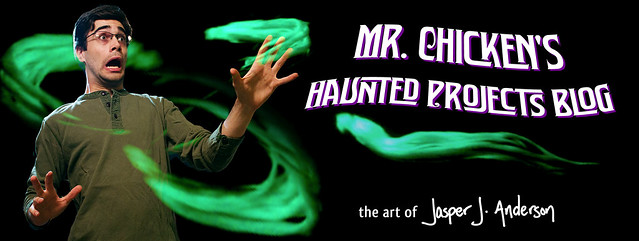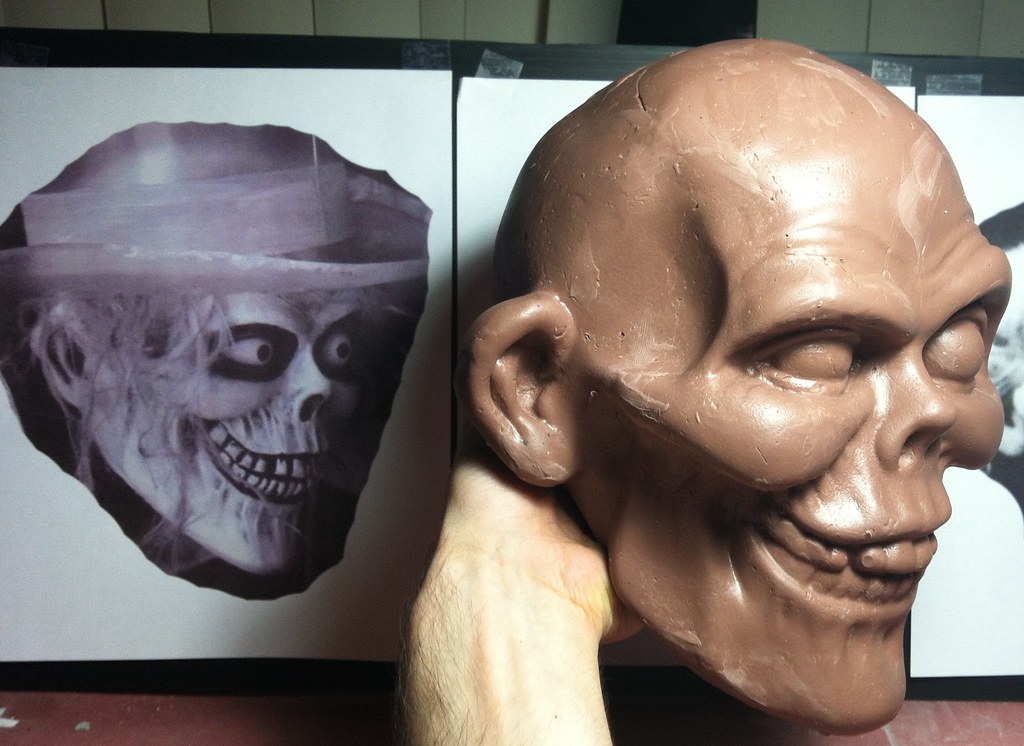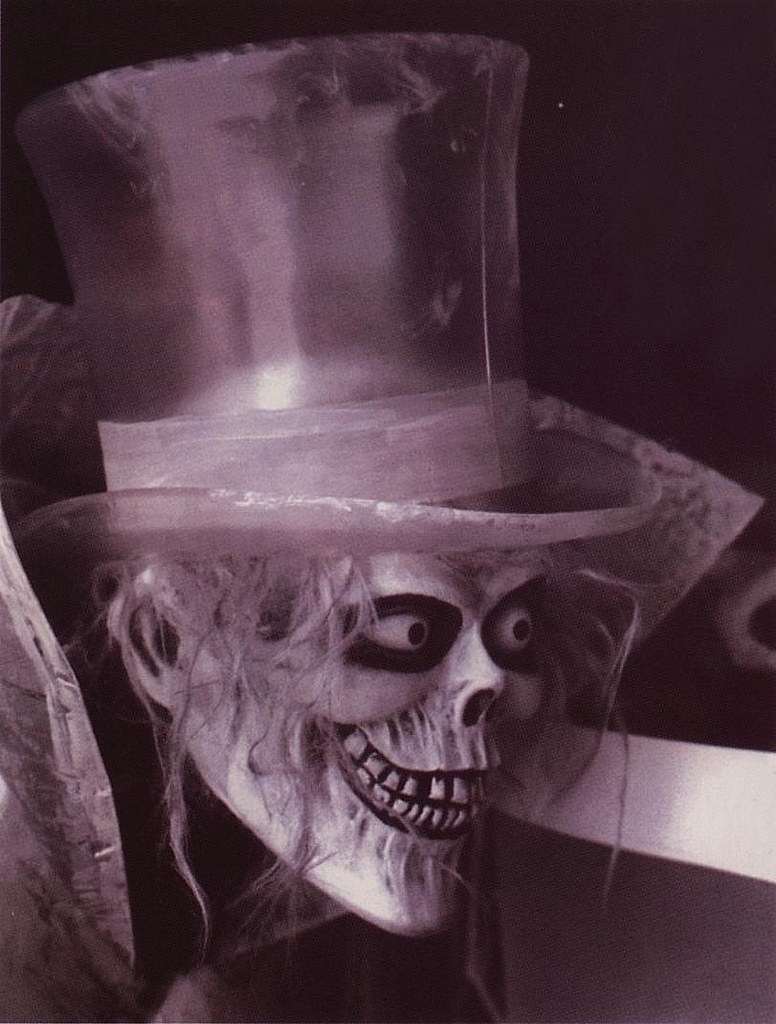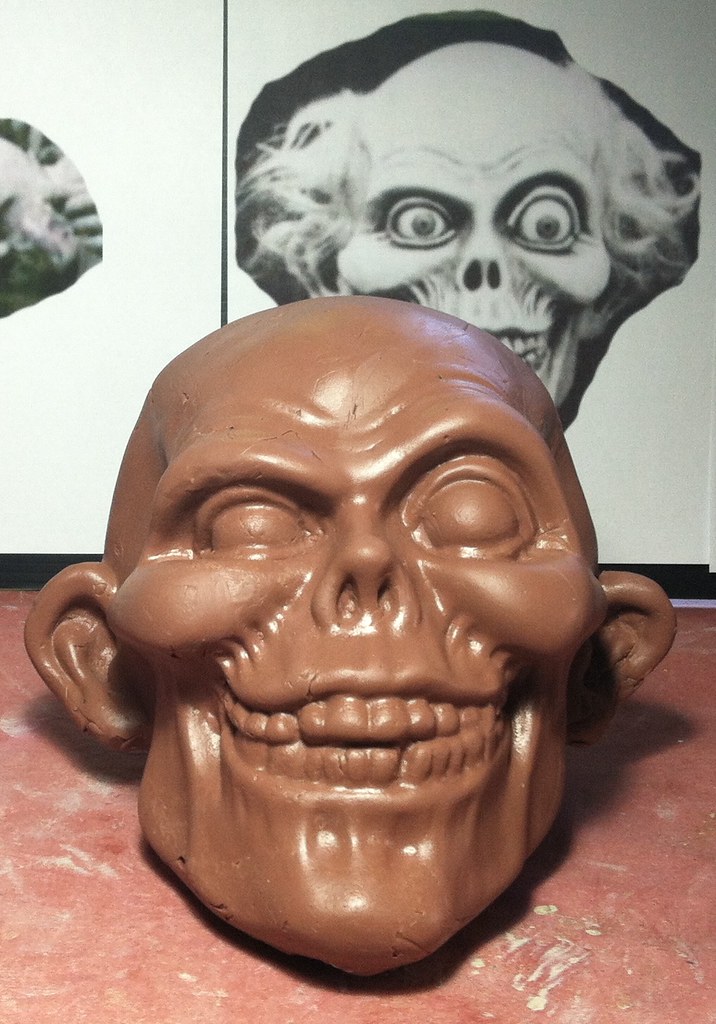Where the Trouble Started
Before I began fixing the sculpture, I needed to analyze what had happened to it. The eBay head itself was painted when I got it, so this was easiest to do once I molded it and cast it in clay. The neutral, uniform color makes it easy to see the forms. Get ready for more detective work.There are basically two ways in which the original sculpture has degraded in the time it got to me. First in detail, and then in overall distortion. From my experience with molding and casting, this is the story of what probably happened. I believe the source for this head was a retired hitchhiking ghost from the mirrors at the end of the ride. We know they have been replaced now and then, because a set was displayed at a Disneyland exhibit a few years back, and there being a few of each ghost in that setup, it seems easiest for one of those to escape unnoticed.
That head probably lived with a Disney employee of some kind, until they loaned it to a friend to mold for themselves. From there, the family tree would have grown many branches, as copies of the head got distributed, and, every so often, remolded. There's no way to say how many generations down from the original the eBay head is, but there are some good clues available about what caused the problems.
This picture is of the clay copy I made of the eBay head.
Perhaps the easiest problem to spot is the softened detail. I've come to the conclusion that this is the result of an earlier generation being pulled from a well used plaster mold. Plaster is a great molding material, but it tends to degrade over time in a way that most other materials do not. Each time a casting is pulled from a plaster mold, it takes a little bit of plaster away with it, especially from the areas that represent deeper grooves and such. If you've ever made a plaster mold for a latex mask, you'll have noticed that detail like skin texture starts to disappear after several pulls, and sharper points, like fangs, start to round off. For my Beast masks, I get about 15 pulls before the mold needs to be retired. Eventually all the detail is softened enough that you need to take a casting from the mold that was made early on and make a new mold from it. This is exactly the kind of degradation seen in the head I have. I'm certain that it was a plaster mold, rather than a plaster casting, that caused the degradation, because you'll notice the nostrils are smaller than the original's. The mold would have had protrusions to represent the nostrils in negative. As it wears down, the protrusion would become shorter and thinner, making the nostril shallower and smaller in proportion to the rest of the nose, which would become bigger all around. And, of course, that's exactly what we see. Were it a plaster casting, we'd see larger than normal nostrils.
There's a good chance that a large part of the softening of the detail happened at Disney. In a recent panel on the new Hatbox Ghost, it was revealed that the source mold of the head in the Disney archives was plaster. Is that where the detail loss started? Maybe. Maybe that original mold was treated as a master mold, and only a couple of castings were made from it so that production molds could be made of those castings to produce the heads seen in the attraction. In that case, that original mold is probably is great shape. But remember that it was hidden and forgotten in the vault for many years. Meanwhile, there are hitchhiking ghosts in both parks that used the same head. We know they need a replacement head now and then, because one of them was displayed at the Reagan Library not too long ago, and that fellow can offer up some further clues.
Notice how he, too, seems to have softened detail all around. It may be a little better off than the head I got, but the teeth are definitely still much more rounded off than the original Hatbox Ghost photos indicate. You see it a lot in the nose, too. I'll bet the original mold was misplaced, and a worn production mold was forced to become the new master mold. That would explain why it's not just the eBay head that's so soft, but also the actual hitchhikers on the ride.
Consider also that, if the only available molds were so degraded, it would indeed have forced WDI to do that resculpt for the 2011 Florida hitchhikers I mentioned in Part 1. Remember that the new figures needed to be matched by digital characters for the second part of the effect. If all they had of the original was as rounded off as the retired hitchhiker is, then there's almost no point scanning it, because there would be tons of cleanup work to do to make it look right when you want to open the mouth or blink the eyes. Better to start from scratch, or at least a clay pour from what you have. And that could very well be what they did. I can't really say.
I briefly considered the possibility that the paint job on the original Hatbox Ghost could be fooling us into thinking that the sculpture is much sharper than it really is, but this photo, especially, reveals that the sculpture is, indeed, crisp and clear in those wrinkles that are round and shallow on the eBay head.
There's no doubt that more detail loss on the eBay head came as a result of the generation loss down the line to mine, but it appears that it did start all the way at the top. There's an overall distortion, however, that almost certainly happened later down the line. The whole head has a droopy look to it, when compared to the original. The eBay casting was not a complete head. It ends just after the sculpture starts to curl under all around the head. That was probably a choice someone made for easier molding. Whether it was the eBay seller or the person they got it from, or even someone before that is hard to say. But, the fact that the bottom of the mold is so open is keeping very much with the idea that the mold sagged. No support on the bottom, and a bad or no rigid shell around the outside would allow a rubber mold (probably silicone) to droop and stretch outward. It would be like if you made a bowl out of rubber and flipped it upside down. It spreads outward under its own weight, and that's what seems to be going on in the eBay head.
UPDATE 12/31/2017:
I learned earlier this year that the hitchhiking ghost heads used on the ride are vacuum formed plastic. Vacuum forming is a process by which a heated sheet of plastic is sucked down over a mold (the "buck"). You can see how I built a simple vacuum forming machine here and here. As a result of the process, there's detail lost in the final product, because the thickness of the plastic smooths over the finer shapes of the original sculpture. This explains the softened detail on the head copies that are out there. Though the copies are resin, they were originally molded off of a vacuum formed head. This also explains the plaster mold, as it is common for vacuum form buck to be made of plaster or stone. It is clear from the Hatbox Ghost photos, however, that he was definitely of a finer detail than the vacuum formed heads, so somehow he was a truer casting of the sculpture by different means. I still believe the overall distortions to be caused by generations of remolding.
Return to Part 1, which introduces the project and provides an appreciation for Blaine Gibson's work on the Hatbox Ghost.
Part 3 covers my sculptural restoration of the Hatbox Ghost head casting.







No comments:
Post a Comment